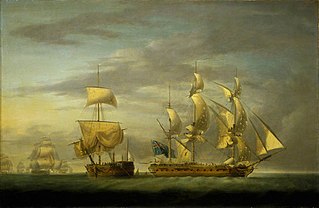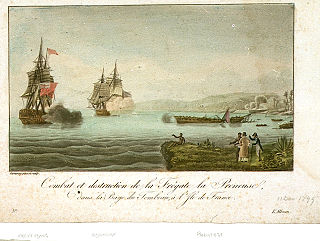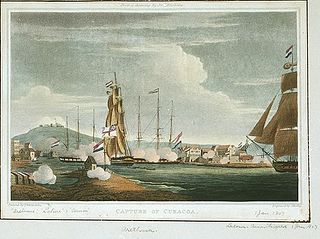HMS Lively was a 32-gun fifth-rate Alcmene-class frigate of the British Royal Navy launched on 23 October 1794 at Northam. She took part in three actions – one a single-ship action, one a major battle, and one a cutting-out boat expedition – that would in 1847 qualify her crews for the issuance of the Naval General Service Medal. Lively was wrecked in 1798.

HMS Santa Margarita was a 36-gun fifth-rate frigate of the Royal Navy. She had been built for service with the Spanish Navy, but was captured after five years in service, eventually spending nearly 60 years with the British.
HMS Braak was an 18-gun brig-sloop of the Royal Navy. She was launched at Rotterdam in 1781 and initially served with the Dutch Republic. The British seized her, in Britain, after the Dutch entry into the French Revolutionary Wars, and took her into the Royal Navy. She served briefly with the British before capsizing off the North American coast. She was subsequently the focus of a number of salvage efforts.

HMS Castor was a 32-gun Amazon-class fifth-rate frigate of the Royal Navy. She served during the French Revolutionary and Napoleonic Wars. The French briefly captured her during the Atlantic Campaign of May 1794 but she spent just 20 days in French hands as a British ship retook her before her prize crew could reach a French port. Castor eventually saw service in many of the theatres of the wars, spending time in the waters off the British Isles, in the Mediterranean and Atlantic, as well as the Caribbean.
HMS Proselyte was a 32-gun Royal Navy fifth-rate frigate. She was the former Dutch 36-gun frigate Jason, built in 1770 at Rotterdam, the Netherlands. Her crew mutinied and turned her over to the British in 1796. She then served the Royal Navy until she was wrecked in 1801.

HMS Adamant was a 50-gun Portland-class fourth rate warship of the British Royal Navy. She served during the American War of Independence, the French Revolutionary Wars, and the Napoleonic Wars in a career that spanned thirty years.
HMS Celebes was the Dutch or Batavian Republic frigate Pallas, under the command of Captain N.S. Aalbers, that the frigate HMS Greyhound and brig-sloop HMS Harrier captured on 26 July 1806 in the East Indies.
Rear-Admiral Sir George Burlton KCB was an officer of the Royal Navy during the Napoleonic Wars.
The Dutch cutter Kemphaan, meaning "game cock", was launched in 1781 as a 12-gun advice boat, with a mission of carrying dispatches between the Netherlands and its colonies. The Dutch increased her length by almost a quarter in 1787, gave her six more guns, and made a brig-sloop out of her. The British captured her in 1799 when they captured Suriname. She then served briefly in the Royal Navy as HMS Camphaan before she was broken up in early 1802.

HMS Halstarr was the Dutch frigate Kenau Hasselar, launched in 1800 that the British captured at Curaçao in 1807. The Royal Navy took her into service but the Admiralty sold her for breaking up in 1809.
The Dutch corvette Scipio was launched in 1784. She convoyed Dutch East Indiamen between the Cape of Good Hope and Europe until HMS Psyche captured her at Samarang in 1807. The British Royal Navy initially referred to her as HMS Scipio, but then renamed her to HMS Samarang in 1808. She was not commissioned in the Royal Navy. She was instrumental in the capture of Amboyna and especially Pulo Ay, and participated in the invasion of Java (1811). She was sold at Bombay in 1814. She then entered mercantile service, sailing between Liverpool and India until 1827. She became an opium trader sailing between India and Canton, and was broken up near Hong Kong in August 1833.

The Dutch ship sloop Havik was launched in 1784 and served in the Batavian Navy. The British captured her in 1796 at the capitulation of Saldanha Bay. She then served briefly in the Royal Navy as HMS Havick before she was wrecked in late 1800.
The Dutch sloop Sireene was launched in 1786. The British captured her in 1796 at the capitulation of Saldanha Bay. She then served in the Royal Navy, first briefly as the sixth rate HMS Daphne, and then from 1798 as the prison ship HMS Laurel. The Admiralty sold her in 1821.

HMS Crescent was a 36-gun Flora-class frigate of the British Royal Navy. Launched in 1784, she spent the first years of her service on blockade duty in the English Channel where she single-handedly captured the French frigate, La Reunion. In 1795, Crescent was part of a squadron commanded by George Elphinstone, that forced the surrender of a Batavian Navy squadron at the capitulation of Saldanha Bay. After serving in the West Indies, Crescent returned to home waters and was wrecked off the coast of Jutland on 6 December 1808.

The Capitulation of Saldanha Bay was the surrender in 1796 to the British Royal Navy of a Dutch expeditionary force sent to recapture the Dutch Cape Colony. In 1794, early in the French Revolutionary Wars, the army of the French Republic overran the Dutch Republic which then became a French client state, the Batavian Republic. Great Britain was concerned by the threat the Dutch Cape Colony in Southern Africa posed to its trade routes to British India. It therefore sent an expeditionary force that landed at Simon's Town in June 1795 and forced the surrender of the colony in a short campaign. The British commander, Vice-Admiral Sir George Elphinstone, then reinforced the garrison and stationed a naval squadron at the Cape to protect the captured colony.

The Invasion of the Cape Colony, also known as the Battle of Muizenberg, was a British military expedition launched in 1795 against the Dutch Cape Colony at the Cape of Good Hope. The Dutch colony at the Cape, established and controlled by the United East India Company in the seventeenth century, was at the time the only viable South African port for ships making the journey from Europe to the European colonies in the East Indies. It therefore held vital strategic importance, although it was otherwise economically insignificant. In the winter of 1794, during the French Revolutionary Wars, French troops entered the Dutch Republic, which was reformed into the Batavian Republic.
Tromp was a Dutch fourth-rate ship of the line launched at Rotterdam in 1777. The Royal Navy captured her at the Capitulation of Saldanha Bay on 17 August 1796. The Royal Navy took her into service as HMS Tromp, sometimes referred to as HMS Van Tromp. In British service she served as a prison, troop, store, guard, hospital, or receiving ship until the Navy sold her in 1815.
HMS Princess was the Dutch East Indiaman Williamstadt en Boetzlaar that the British Royal Navy captured on 18 August 1795 at the Capitulation of Saldanha Bay. The Royal Navy initially rated her a 28-gun sixth rate. She quickly became a receiving ship, a guard ship, and a floating battery. The Navy sold her in 1816.
Between 1793 and 1805, five cutters served the British Royal Navy as hired armed vessels under the designation HM hired cutter Rose:
The Dutch naval brig Meermin was built at Flushing; the Zeeland Admiralty purchased her in 1784. The British Royal Navy seized her in 1796. The Royal Navy named her HMS Miermen and registered but never commissioned her; it sold her in 1801.







